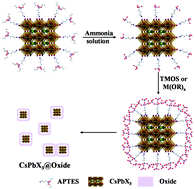A universal synthesis strategy for stable CsPbX3@oxide core–shell nanoparticles through bridging ligands†
Abstract
CsPbX3 (X = Cl, Br, I) nanocrystals (NCs) have shown great potential in various optoelectronic devices due to their excellent photophysical properties. However, the poor stability has severely impeded their practical applications. Much effort has been devoted to the preparation of monodisperse core–shell NCs to improve the stability of CsPbX3 NCs. However, it is still challenging to develop a general method to coat CsPbX3 NCs with oxides at the single-particle level. In this work, we report a simple way to prepare monodisperse CsPbX3@SiO2/Ta2O5/ZrO2 core–shell structure NCs using 3-aminopropyl triethoxysilane (APTES) as a bridging ligand. It has been found that careful control of the hydrolysis and condensation process of oxide precursors is critical for the successful preparation of CsPbX3@oxide core–shell NCs. The stability of CsPbI3 NCs upon attack of water, UV-light irradiation, and heating before and after the oxide shell growth has been investigated, demonstrating the efficient protective effect of oxide shells. This work not only provides a novel and universal approach for coating the individual CsPbX3 nanocrystal with various oxide shells but also paves the way for potential practical applications of CsPbX3 NCs because of the enhanced stability.



 Please wait while we load your content...
Please wait while we load your content...